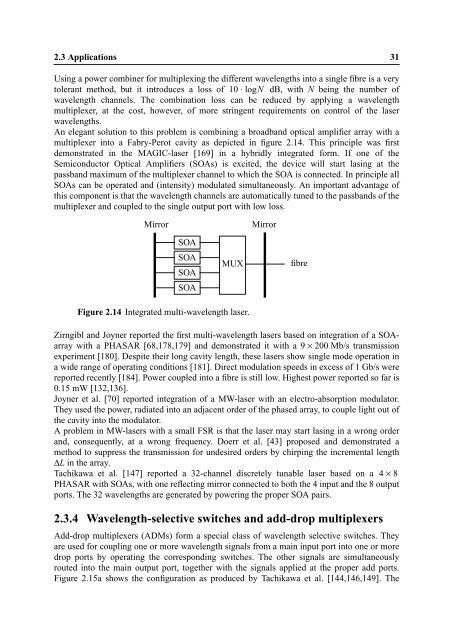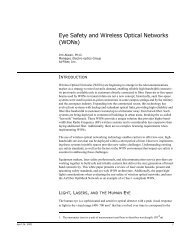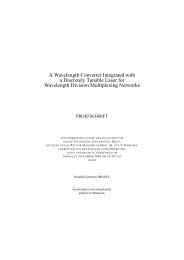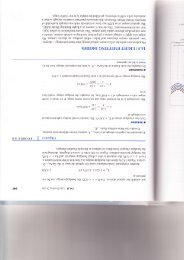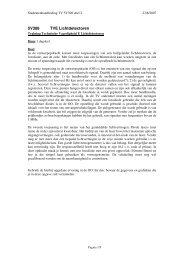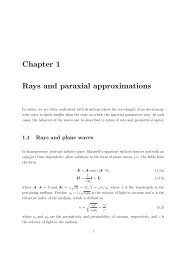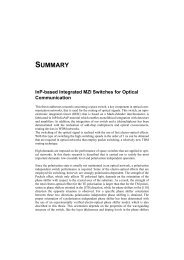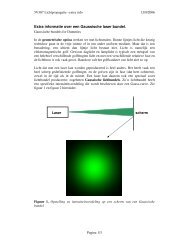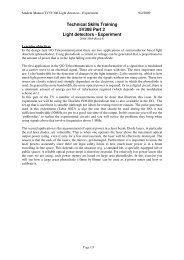InP-based polarisation independent wavelength demultiplexers
InP-based polarisation independent wavelength demultiplexers
InP-based polarisation independent wavelength demultiplexers
You also want an ePaper? Increase the reach of your titles
YUMPU automatically turns print PDFs into web optimized ePapers that Google loves.
2.3 Applications 31<br />
Using a power combiner for multiplexing the different <strong>wavelength</strong>s into a single fibre is a very<br />
tolerant method, but it introduces a loss of 10 ⋅ logN dB, with N being the number of<br />
<strong>wavelength</strong> channels. The combination loss can be reduced by applying a <strong>wavelength</strong><br />
multiplexer, at the cost, however, of more stringent requirements on control of the laser<br />
<strong>wavelength</strong>s.<br />
An elegant solution to this problem is combining a broadband optical amplifier array with a<br />
multiplexer into a Fabry-Perot cavity as depicted in figure 2.14. This principle was first<br />
demonstrated in the MAGIC-laser [169] in a hybridly integrated form. If one of the<br />
Semiconductor Optical Amplifiers (SOAs) is excited, the device will start lasing at the<br />
passband maximum of the multiplexer channel to which the SOA is connected. In principle all<br />
SOAs can be operated and (intensity) modulated simultaneously. An important advantage of<br />
this component is that the <strong>wavelength</strong> channels are automatically tuned to the passbands of the<br />
multiplexer and coupled to the single output port with low loss.<br />
Mirror<br />
SOA<br />
SOA<br />
SOA<br />
SOA<br />
MUX<br />
Figure 2.14 Integrated multi-<strong>wavelength</strong> laser.<br />
Mirror<br />
Zirngibl and Joyner reported the first multi-<strong>wavelength</strong> lasers <strong>based</strong> on integration of a SOAarray<br />
with a PHASAR [68,178,179] and demonstrated it with a 9 × 200 Mb/s transmission<br />
experiment [180]. Despite their long cavity length, these lasers show single mode operation in<br />
a wide range of operating conditions [181]. Direct modulation speeds in excess of 1 Gb/s were<br />
reported recently [184]. Power coupled into a fibre is still low. Highest power reported so far is<br />
0.15 mW [132,136].<br />
Joyner et al. [70] reported integration of a MW-laser with an electro-absorption modulator.<br />
They used the power, radiated into an adjacent order of the phased array, to couple light out of<br />
the cavity into the modulator.<br />
A problem in MW-lasers with a small FSR is that the laser may start lasing in a wrong order<br />
and, consequently, at a wrong frequency. Doerr et al. [43] proposed and demonstrated a<br />
method to suppress the transmission for undesired orders by chirping the incremental length<br />
ΔL in the array.<br />
Tachikawa et al. [147] reported a 32-channel discretely tunable laser <strong>based</strong> on a<br />
PHASAR with SOAs, with one reflecting mirror connected to both the 4 input and the 8 output<br />
ports. The 32 <strong>wavelength</strong>s are generated by powering the proper SOA pairs.<br />
2.3.4 Wavelength-selective switches and add-drop multiplexers<br />
Add-drop multiplexers (ADMs) form a special class of <strong>wavelength</strong> selective switches. They<br />
are used for coupling one or more <strong>wavelength</strong> signals from a main input port into one or more<br />
drop ports by operating the corresponding switches. The other signals are simultaneously<br />
routed into the main output port, together with the signals applied at the proper add ports.<br />
Figure 2.15a shows the configuration as produced by Tachikawa et al. [144,146,149]. The<br />
fibre<br />
4 ×<br />
8


